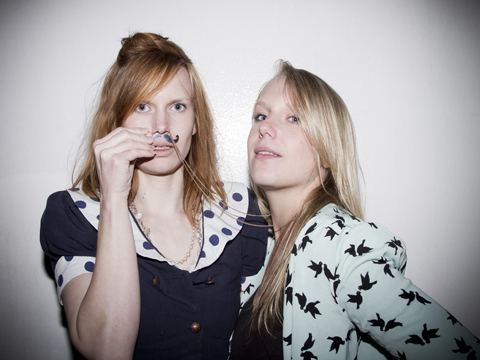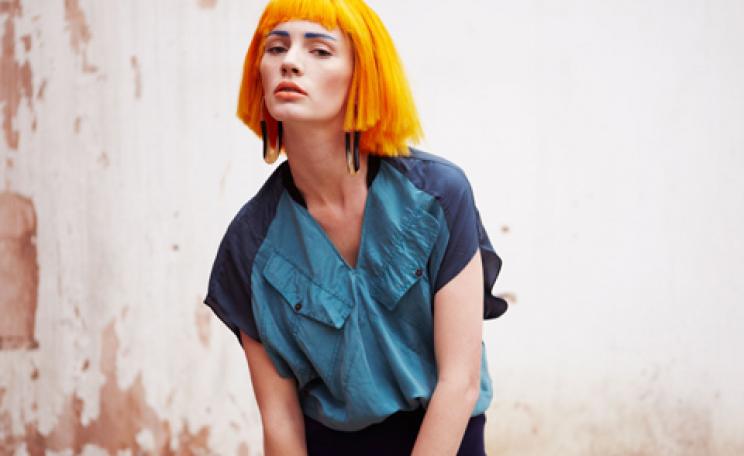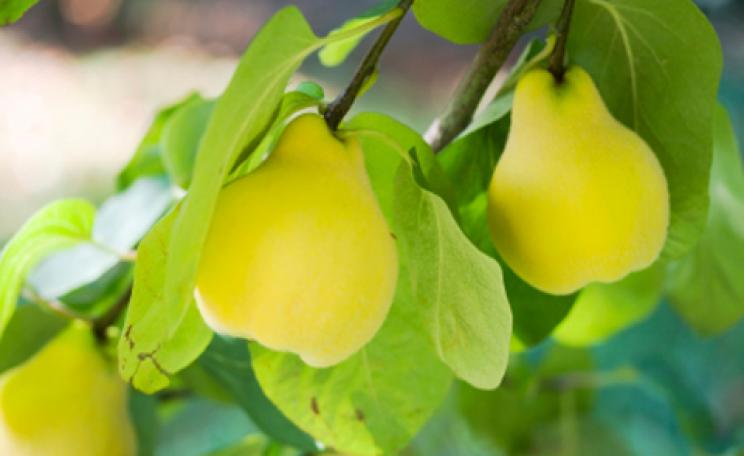Copenhagen might be better known as the Scandinavian capital of cool but it’s also built up quite a reputation for its focus on all things green, whether that’s travel by bike or renewable technology. Not surprisingly then, in a country where style and sustainability have equal cachet, the Danish fashion industry is one of the greenest on the planet. From all-natural fabrics to ethical manufacturing, Danish brands are world leaders in combining an eco ethos with desirable ready-to-wear. Whether it’s SPON DIOGO’s mix of impressive tailoring and first rate CSR or Jackpot bringing Marimekko-esque prints and organic cotton to the high street, Danish brands have plenty for the eco-fashionista to love. And top of the wishlist right now, are pieces by one of Copenhagen’s most hotly tipped young design duos: Stine Bauer Boskov and Julie Villumsen, aka The Baand.
Launched in 2009, The Baand specialises in seriously cool basics with a quirky fashion edge, and it goes without saying, emerald green eco credentials. ‘From the very beginning when I went to school I was taught about how the clothing industry was affecting the climate and the environment,’ says Stine. ‘It was one of the things that I wanted to do. I wanted to make clothes but I wanted to make them in a better way. And then I learnt that it was possible to do it in a better way.’ In Stine and design partner, Julie Villumsen’s case, the epiphany came on a trip to Peru where the twosome’s clothes are made. ‘We had a opportunity to go to Lima and it was a really, really fantastic trip,’ says Stine. ‘The quality of the cotton was amazing. So, it was so easy to say “okay, we will move all of our production to Peru” because this is really unique.’ And Peru had more than top quality organic cotton in its arsenal. It also had a network of ethically sound family-run co-operatives that could turn the duos designs into Fairtrade fashion that outlasted the high street competition.
 ‘What we like to do is create clothes that can last for a really long time,’ explains Stine. ‘It's important for us that the quality is so good so we can use it for many seasons, and it's not just on trend: it's something you can use forever. We used to do a complete collection and we never really felt, 'This is what we want to do for the rest of our lives.' It wasn't super successful. We got a lot of attention but it was never like, “this is what we're meant to do,” because every season you have to come up with a new collection, with a new theme and it just didn't really feel right. Now it's all fallen into place. It feels so much more relaxed, so much more confident, it's who we really are.’
‘What we like to do is create clothes that can last for a really long time,’ explains Stine. ‘It's important for us that the quality is so good so we can use it for many seasons, and it's not just on trend: it's something you can use forever. We used to do a complete collection and we never really felt, 'This is what we want to do for the rest of our lives.' It wasn't super successful. We got a lot of attention but it was never like, “this is what we're meant to do,” because every season you have to come up with a new collection, with a new theme and it just didn't really feel right. Now it's all fallen into place. It feels so much more relaxed, so much more confident, it's who we really are.’
Not that The Baand don’t do seasonal collections; it’s just that they do them smaller and less often than most high street and designer brands. ‘We still do a collection every season [but] a lot of the styles are the same; it's just the colours that change,’ says Stine. ‘But that's just because that's how the fashion industry works. We don't do a collection every six weeks or every two weeks like H&M but we do one every six months, and that works for us. And it also feels right because you can change the colours, but you can still combine them with the colours you had from last season or the season before. Like today when Julie is wearing a t-shirt that's two and a half years old, but still feels right, the colour is still in fashion.’
 The collection for A/W12 takes up less than a single rail and is almost entirely focused on t-shirts and sweatshirts in muted shades of white, dove grey and a soft pink that’s almost the colour of China clay. It’s not the riot of wildly different shapes, textures and hues that most high street shoppers have come to expect, but it’s fabulous quality – as a quick feel of the fabric swiftly proved – and extremely wearable. That, as Stine is at pains to emphasise, is the point. ‘We have to play by the rules of the fashion industry, otherwise you get no customers,’ she explains. ‘You have to deliver a new collection, you have to understand how the business works because a lot of our customers also go to H&M and buy some things that are just here now. Then they also try out t-shirts and maybe that's when they start thinking a little bit more, “Okay maybe I can buy my basics maybe last longer and I can combine them with something that's a little bit more just for the moment.” The idea of longevity in fashion isn’t new, with vintage, eco-friendly and luxury labels all pushing the concept of the investment piece but it’s something that’s so far eluded most of the high street – and its core clientele.
The collection for A/W12 takes up less than a single rail and is almost entirely focused on t-shirts and sweatshirts in muted shades of white, dove grey and a soft pink that’s almost the colour of China clay. It’s not the riot of wildly different shapes, textures and hues that most high street shoppers have come to expect, but it’s fabulous quality – as a quick feel of the fabric swiftly proved – and extremely wearable. That, as Stine is at pains to emphasise, is the point. ‘We have to play by the rules of the fashion industry, otherwise you get no customers,’ she explains. ‘You have to deliver a new collection, you have to understand how the business works because a lot of our customers also go to H&M and buy some things that are just here now. Then they also try out t-shirts and maybe that's when they start thinking a little bit more, “Okay maybe I can buy my basics maybe last longer and I can combine them with something that's a little bit more just for the moment.” The idea of longevity in fashion isn’t new, with vintage, eco-friendly and luxury labels all pushing the concept of the investment piece but it’s something that’s so far eluded most of the high street – and its core clientele.
‘We think it's a big shame that H&M also make basics but they make it in such bad quality that it doesn't last for a very long time,’ says Stine. ‘So people just throw it out and it’s just such a waste of cotton and also the energy to make it. We think that customers should just buy something that will actually last for at least three years - that would be better for the environment. Also you have to remember organic cotton is not better than, for example, polyester. Polyester uses less energy, lasts longer but high quality organic cotton is a lot better than poor quality conventional cotton. And that's what we like and we really like the fact that you can just focus on high quality - good quality - that lasts for a long time. It's not something that you need to put away for many years; it can really become your favourite.’ The same goes for The Baand.
For more information, see www.thebaand.com
| READ MORE... | |
 |
GREEN LIVING Urban legend: THTC takes environmentalism to the streets Eco-label THTC has launched a new range of organic cotton t-shirts in association with the Soil Association, the Carbon Trust and the Fair Wear Foundation |
 |
GREEN LIVING Five of the best…organic cotton t-shirts Whether you’re taking up pilates or just going for a jog, there’s an fabulous eco-friendly t-shirt for you |
 |
GREEN LIVING High street giant H&M pledges to change its ways In the wake of a Greenpeace campaign, H&M has agreed to put an end to polluting practices. So could this be the start of a new trend? Hannah Corr reports |
 |
GREEN LIVING Risqué business: how Holloway-Smith Noir is making burlesque fashionably green Eco-friendly smalls anyone? Green Living editor Ruth Styles meets the duo turning burlesque glamour into planet-pleasing nipple pasties |
 |
GREEN LIVING The Ecologist guide to Estethica London’s environmental fashion initiative celebrates its fifth birthday this year and this season looks set to be the best yet. Ruth Styles takes a closer look |








